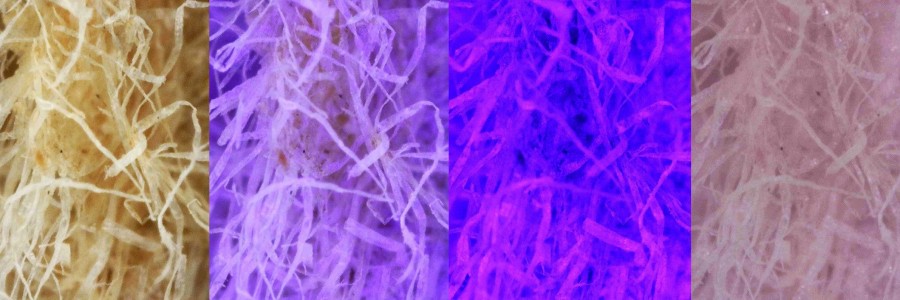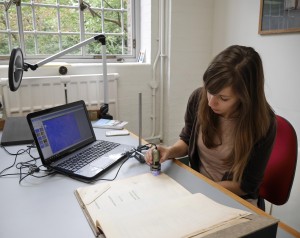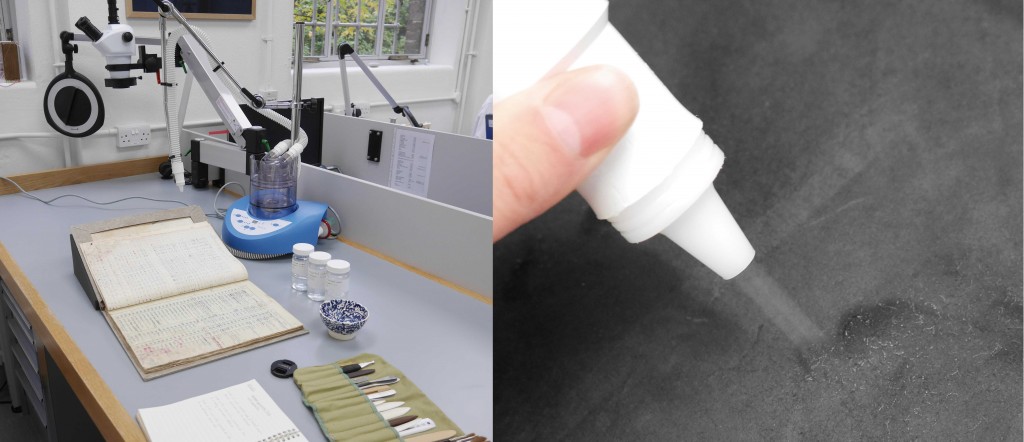
Under the Microscope – Preliminary Investigations of the Changi Archive Conservation Research Project
You may have seen here that in May this year I was awarded a Research Bursary from the Wellcome Trust. The award means that I am able to carry out an exciting project investigating and treating damage suffered by one of the Changi Archive Nominal Rolls, alongside my continued conservation work as Project Conservator of the WWII Changi Archive.
The Nominal Rolls of Singapore’s civilian internment camps date from 1942 to 1945, and are important historical documents recording the internees’ personal data. They list name, date entered camp, marital status, occupation, age, nationality and camp address, and were arranged in three parts – men, women and children. One of the Rolls has extensive moisture and ink damage meaning it cannot be safely handled or digitised. It is this Roll which is the focus of the research project.
The project has two main threads; investigation into the paper characteristics and moisture damage of the Nominal Roll’s paper leaves, and the development of a suitable and sympathetic conservation treatment for them.
(please click on the images to enlarge them)

Changi Archive Conservator Emma Nichols and Doctoral Researcher Natalie Brown examining paper fibres with the Keyence VHX 5000 digital microscope
In July my conservation colleague Anna Johnson and I spent a day with Doctoral Researcher Natalie Brown at the Institute for Sustainable Heritage at University College London (UCL). Natalie and I both graduated from the Book and Paper Conservation MA at Camberwell College of Arts in 2013 and very much enjoyed the opportunity of working together again. Thanks to Natalie, we were able to carry out non-destructive analysis and characterisation tests of the Nominal Roll’s paper fibres and damaged areas using the lab’s Keyence VHX 5000 digital microscope and SurveNIR, a near-infrared spectroscopy system which was developed to analyse the chemical and physical properties of paper.
Some of the money from the research bursary paid for new multispectral imaging equipment for the University Library’s Digitisation Department. Working with University Library Photographers Maciej Pawlikowski and Scott Maloney we have been using Ultra Violet (UV) imaging for photographing the leaves of the Nominal Roll.
UV light is a great aid for revealing historical moisture and mould damage to paper which is not necessarily visible to the naked eye. Areas previously immersed or flushed with water, where size and the products which cause fluorescence have been removed, appear darker under UV light.

(L) University Library Photographer Maciej Pawlikowski capturing UV images of the Nominal Roll (R) Fluorescence of the Nominal Roll paper under UV light

(L) A leaf of the Nominal Roll under visible light next to the same leaf under UV light captured at 550nm with a 15 second exposure (R) University Library Photographer Scott Maloney carrying out post production of the UV images
Using a small handheld microscope owned by the Conservation Department, known as a Dino-Lite, I have been able to supplement the large UV images with smaller ones of greater detail. The microscope has three settings – UV, Infra-Red and Visible Light, has a maximum magnification of up to 250x and can capture images and film which can be annotated.

The same area of Nominal Roll paper fibres captured at 230x magnification using the Dino-Lite. (L-R) Visible light, UV + Visible light, UV light, and Infra-Red light
All of the information gathered from the microscopes, near infra-red analysis and UV imaging gives a clearer idea about the characteristics of the paper and how damaged it is. I am using this information to aid my decisions around forming a suitable conservation treatment.
I have begun the first steps of treatment testing by carrying out experiments with the Conservation Department’s new ultrasonic aerosol generator. This piece of equipment, originally designed for medical use, allows patients to breathe medicines as a mist.
The aerosol generator is useful for conservation treatments as it offers a gentle and controlled way of delivering water and adhesive as a vapour to an item’s surface. This is particularly useful when working with delicate substrates or fugitive inks and is used in the conservation of paintings for consolidating paint layers.
My aim is to use an adhesive vapour to add strength to the Nominal Roll’s vulnerable paper areas. A fine adhesive layer will also help with the application of supportive repair tissues.
If you are keen to learn more, my archive and digitisation colleagues and I will be presenting on the project at the Cambridge University Science Festival on Saturday 25th March 2017. The event will be free but ticketed, so keep your eyes peeled! There will also be a small exhibition of Changi Archive material in the UL entrance hall cases from 20th February to 25th of March 2017.








Thank you for an interesting blog-post! I’m considering purchasing a Dino-Lite microscope and would like to know which model your department is using.
Hello Victoria
I’m glad you found the blog interesting. Our Dino-Lite microscope is a Dino-Lite Premier 2 AD4113T-I2V(R4)
All best wishes
Emma
Dear Emma,
I am looking for a copy of Changi Guardian, vol. 81, dated 2o June 1942. Would you happen to have copies of this internee paper? I will appreciate any help you can give me.
Siew
Dear Siew
A copy of this can be found on Cambridge Digital Library at – https://cudl.lib.cam.ac.uk/view/MS-RCMS-00103-00012-00029/139
Hope this is what you were looking for
Best wishes
Emma